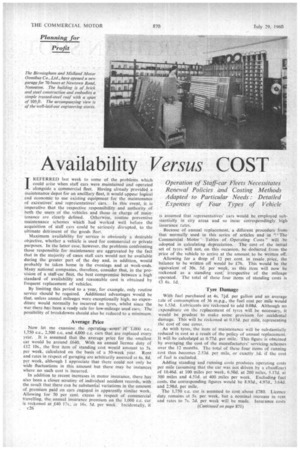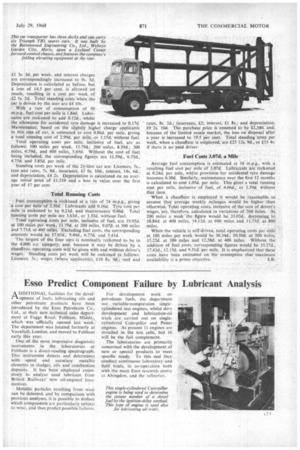Availability Versus COST I REFERRED last week to some of the
Page 62

Page 65

If you've noticed an error in this article please click here to report it so we can fix it.
problems which could arise when staff cars were maintained and operated alongside a commercial fleet. Having already provided a maintenance depot for an ancillary fleet, it would appear logical and economic to use existing equipment for the maintenance of executives' and representatives cars. In this event, it is imperative that the respective responsibility and authority of both the users of the vehicles and .those in charge of main tenance are clearly defined. Otherwise, routine preventive maintenance schemes Which had worked well before the acquisition of staff cars could be seriously disrupted, to the ultimate detriment of the goods fleet.
Maximum availability for service is obviously a desirable objective, whether a vehicle is used for commercial or private purposes. In the latter case, however, the problems confronting those responsible for maintenance are aggravated by the fact that in the majority of cases staff. cars would not be available during the greater part of the day and, in addition,. would probably be taken home in the evenings and at week-ends. Many national companies, therefore, consider that, in the provision of a staff-car fleet, the best compromise between a high standard of availability and reasonable cost is obtained by frequent replacement of vehicles.
By limiting this period to a year, for example, only routine service should be required. Additional advantages would be that, unless annual mileages were exceptionally high, no expenditure would normally be incurred on tyres, whilst since the war there has been a ready sale for low-mileage used cars. The possibility of breakdowns should also be reduced to a minimum.
Average Price Now let me examine the operating costs of 1,000 c.c., 1,750 c.c., 2,500 c.c. and 4,000 c.c. cars that are replaced every year. It is assumed that the average price for the smallest car would be around £640. With an annual licence duty of £12 10s., the first item of standing cost would amount to 5s. per week, calculated on the .basis of a 50-week' year. Rent and rates in respect of garaging are arbitrarily assessed at 6s. 8d. per week, although I appreciate that there could not only be wide fluctuations in this amount but there may be instances where no such cost is incurred.
In addition to recent increases in motor insurance, there has also been a closer scrutiny of individual accident records, with the result that there can be substantial variations in the amount of premium paid on cars engaged in apparently similar work. Allowing for 50 per cent, excess in respect of commercial travelling, the annual insurance premium on the 1,000 c.c. car is reckoned at ,£40 17s., or 16s. 5d. per week. Incidentally, it
c26 is assumed that representatives' cars would be employed substantially in city areas and so incur correspondingly high insurance rates.
Because of annual replacement, a different procedure from that normally used in this series of articles and in " `The' Commercial Motor '• Tables of_ Operating Costs" will .be adopted in calculating depreciation. The cost of the initial set of tyres will not, on this occasion, be deducted from the price of the vehicle to arrive at the amount to he written off.
Allowing for a drop of 12 per cent. in resale price, the balance to be written off would be £76. This would be the equivalent of 30s. 5d. per week, as this item will now be reckoned as a standing cost! irrespective of the mileage operated. The total of these four items of standing costS" is €3 Gs. Id..
Tyre Damage
With fuel purchased at 4s. 70. per gallon and an average rate of consumption of 36 m.p.g., the fuel cost per mile would be 1.53d. Lubricants are reckoned to add 0.08d. Although no expenditure on the replacement of tyres will be necessary, it would be prudent to make some provision for accidental damage. This will be reckoned at 0.15d. per mile, representing the cost of one cover.
As with tyres,. the item of maintenance will be substantially reduced in cost as a result of the policy of annual replacement. It will be cakulatFd at 0.77d. per mile. This figure is obtained by averaging the cost of the manufacturers' servicing schemes over the 12 months. The total of these .four items of running cost thus becomes 2.53d. per mile, or exactly ,1d. if the cost of fuel is excluded.
Adding standing and running costs produces operating costs per mile (assuming that the car was not driven by achauffeur) of 10.46d. at 100 miles per week, 6.50d. at 200 miles, 5.17d. at 300 miles and 4.51d. at 400 miles per week. Excluding fuel costs, the corresponding figures would be 8.93d., 4.97d., 3.64d. and 2.98d. per mile.
The 1,750 c.c. car, is assumed to cost about £780. Licence duty remains at 5s. per week, hut a nominal increase in rent and rates to 7s. 2d. per week will be made. Insutance costs (Continued on page 871)
I 35. 3d. per week, and interest charges are correspondingly increased to 9s. 5d. Depreciation is calculated as before. but a loss of 14.5 per cent, is allowed on resale, resulting in a cost per week of £2 5s. 2d. Total standing costs when the car is driven by the user are £4 10s. • ' With a rate of consumption of 30 m.p.g., fuel cost per mile is 1.84d. Lubricants are reckoned to add 0.12d.. whilst the allowance for accidental tyre damage is increased to 0.17d. Maintenance, based on the slightly higher charge applicable to this size of car, is estimated to cost 0.86d. per mile, giving a total running cost of 2.99d. per mile, or 1.15d. withont fuel.
Total operating costs per mile, inclusive of fuel, are as follows: 100 miles per week. 13.79d4 200 miles, 8.39d.; 300 miles, 6.59d., and 400 miles, 5,69d. Without the cost of fuel being included, the corresponding figures are 11.59d., 6.55d., 4.75d. and 3.85d. per, mile.
• Standing costs per week of the 2f-litre car are: Licences, 5s., rent and rates, 7s. 8d., insurance, £1 6s. 10d., interest, 14s. 6d., and depreciation, £4 2s. ' Depreciation is calculated on an average initial price of .£1,210 and a less in, value over the first year of 17 per cent.
Total Running Costs
Fuel consumptibn, is reckoned at a rate of 24 m.P.g., giving a cost per mile of 2.30d. Lubricants add 0.16d. Tyre `cost per mile is reckoned to be 0.21d. and maintenance 0.96d. Total running costs per mile arc 3.63d., or 1.33d. without fuel.
Total operating costs per mile, inclusive of fuel, are 19.95d. at 100 miles per week, 11.79d. at 200 miles, 9,07d. at 300 miles and 7.71d. at 400 miles. Excluding fuel costs, the corresponding amounts would be 17.65d., 9.49d., 6.77d. and 5.41d.
The largest of the four cars is nominally reckoned to he in the 4,000 c.c. category, and, because it may be driven by a chauffeur, operating costs will be given with and without driver's wages. Standing costs per week will be reckoned as follows: Licences. 5s.; wages (where applicable), £10 8s. 9d.; rent and rates, 8s. 2d.; insurance, £2; interest, £1 8s.; and depreciation. £9 2s. 10d. The purchase price is assumed to be £2,340, and, because of the limited resale market, the loss on disposal after a year is increased to 19.5 per cent. Total standing costs per week, when a chauffeur is employed, are £23 12s. 9d., or £13 4s. if there is no paid driver.
Fuel Costs 3.07d. a Mile Average fuel consumption is estimated at 18 m.p.g., with a resulting fuel cost per mile of 3.07d. Lubricants are reckoned at 0.24d. per mile, whilst provision for accidental tyre damage becomes 0.30d. Similarly, maintenance over the first 12 months is calculated to cost 1.05d, per mile. This gives.' a total running cost per mile, inclusive of fuel, of 4.66d., or 1.59d. without that item.
When a chauffeur is employed it would be reasonable to , assume that average weekly mileages would be higher than otherwise. Total operating costs, inclusive of the cost of driver's wages, are, therefore, calculated in variations of 200 miles. At 200 miles a week 'the figure would be 33.03d.. decreasing to 18.84d. at 400 miles, 14.12d. at 600 miles and 11.75d. at 800 miles.
When the vehicle is self driven total operating costs per mike at 100 miles per week would be 36.34d., 2030d. at 200 miles, 15.22d. at 300 miles and I2.58d. at 400 miles. Without the addition of fuel costs, corresponding figures would be 33.27d.. I7.43d., 12.15d. and 9.5W. per mite. It is emphasized that these costs have been estimated on the assumption that niaximuin availability is a prime objective. S.B.








































































































